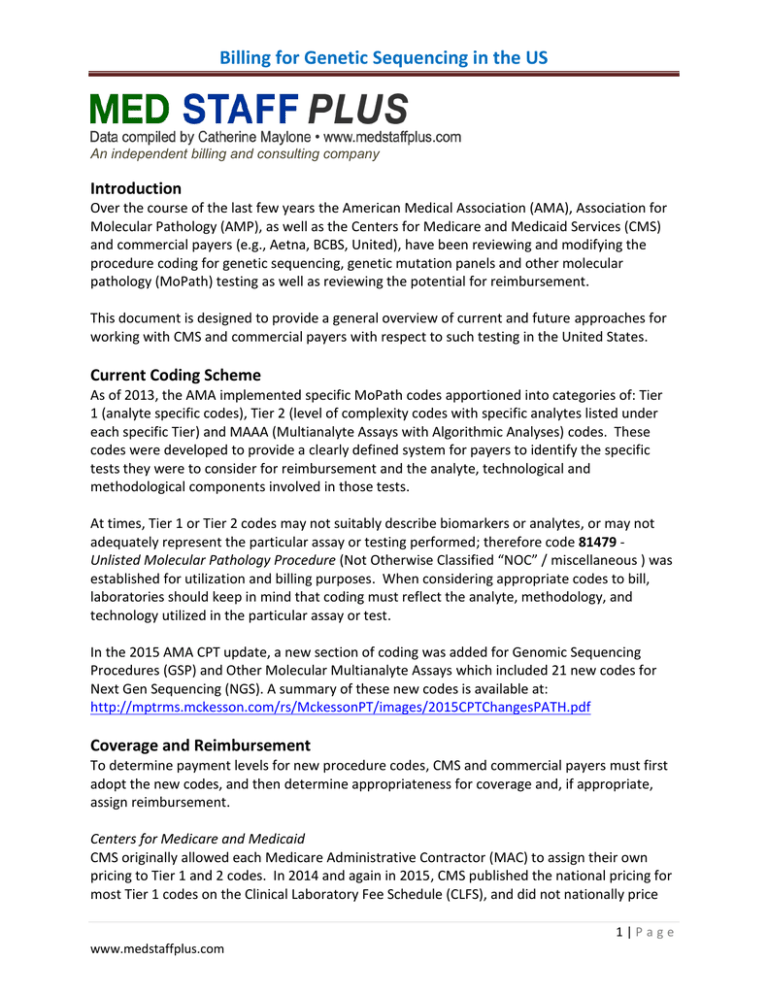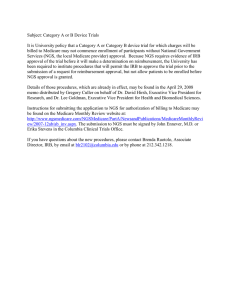Billing for Genetic Sequencing in the United States (US)
advertisement

Billing for Genetic Sequencing in the US An independent billing and consulting company Introduction Over the course of the last few years the American Medical Association (AMA), Association for Molecular Pathology (AMP), as well as the Centers for Medicare and Medicaid Services (CMS) and commercial payers (e.g., Aetna, BCBS, United), have been reviewing and modifying the procedure coding for genetic sequencing, genetic mutation panels and other molecular pathology (MoPath) testing as well as reviewing the potential for reimbursement. This document is designed to provide a general overview of current and future approaches for working with CMS and commercial payers with respect to such testing in the United States. Current Coding Scheme As of 2013, the AMA implemented specific MoPath codes apportioned into categories of: Tier 1 (analyte specific codes), Tier 2 (level of complexity codes with specific analytes listed under each specific Tier) and MAAA (Multianalyte Assays with Algorithmic Analyses) codes. These codes were developed to provide a clearly defined system for payers to identify the specific tests they were to consider for reimbursement and the analyte, technological and methodological components involved in those tests. At times, Tier 1 or Tier 2 codes may not suitably describe biomarkers or analytes, or may not adequately represent the particular assay or testing performed; therefore code 81479 Unlisted Molecular Pathology Procedure (Not Otherwise Classified “NOC” / miscellaneous ) was established for utilization and billing purposes. When considering appropriate codes to bill, laboratories should keep in mind that coding must reflect the analyte, methodology, and technology utilized in the particular assay or test. In the 2015 AMA CPT update, a new section of coding was added for Genomic Sequencing Procedures (GSP) and Other Molecular Multianalyte Assays which included 21 new codes for Next Gen Sequencing (NGS). A summary of these new codes is available at: http://mptrms.mckesson.com/rs/MckessonPT/images/2015CPTChangesPATH.pdf Coverage and Reimbursement To determine payment levels for new procedure codes, CMS and commercial payers must first adopt the new codes, and then determine appropriateness for coverage and, if appropriate, assign reimbursement. Centers for Medicare and Medicaid CMS originally allowed each Medicare Administrative Contractor (MAC) to assign their own pricing to Tier 1 and 2 codes. In 2014 and again in 2015, CMS published the national pricing for most Tier 1 codes on the Clinical Laboratory Fee Schedule (CLFS), and did not nationally price 1|Page www.medstaffplus.com Billing for Genetic Sequencing in the US any of the Tier 2 codes, leaving those CPT codes to be priced by the individual MACs where appropriate. With respect to the 21 new NGS codes, CMS has indicated that valuations will be based on the “Gapfill1” Payment Determination process. As part of the gapfilling process, after the MACs have gathered utilization and billing data for the new NGS codes, they will submit final code valuations to CMS in August or September 20152. CMS will review those valuations and potentially publish median valuation for those codes; those valuations may be included in the 2016 CLFS. In some cases a MAC may not submit a valuation for a given NGS code; this may be due to one of several reasons, including: The test not having a benefit category; There is a lack of published peer-reviewed evidence demonstrating clinical utility for the test; The utilization of the test does not meet medical necessity criteria for the specific beneficiary; There is no technical assessment that qualifies the test for coverage. Commercial Payers Like the MACs, commercial payers continue to review existing and novel tests to establish appropriateness of use and medical necessity criteria for their clinical and medical policies. Often commercial payers will follow applicable medical societies’ recommendations on tests’ clinical utilization, however laboratories should always keep in mind that coverage of a particular test is dependent on the patient’s specific benefit plan. All questions regarding coverage of a particular test should be directed to the appropriate payer. Many commercial payers utilize the Medicare’s Clinical Laboratory Fee Schedule (CLFS) as a basis, or a percentage thereof, for determining an allowable amount for tests. The commercial payer’s allowable fee schedule maybe used for both contracted and noncontracted (out-of-network) laboratories. Laboratories should contact their contracted and local payers for specifics on reimbursement, fee schedules and CPT code valuations. Depending on the commercial payer, it may be beneficial to confirm benefits and medical necessity by obtaining a prior authorization before performing a genetic test or when a laboratory knows they will be submitting a claim with a miscellaneous code. 1 The Gapfilling process is used for a new clinical diagnostic lab test when no comparable existing test is available. Additional information about criteria and process for gapfilling may be found in 42 CFR 414.508(b). 2 In June 2015, CMS published an interim gap-filling fee schedule for one Medicare Administrative Contractor (MAC), Cahaba (covering Georgia, Alabama, and Tennessee) at a rate of $90.00 for 81445 and 81450. http://www.cms.gov/Medicare/Medicare-Fee-for-Service-Payment/clinicallabfeesched/gapfill-pricing-inquiries.html 2|Page www.medstaffplus.com Billing for Genetic Sequencing in the US Approaches for the Future Historically, payer medical policy was geared toward clinical utilization (test results assisting in the decision regarding a treatment or procedure), but the trend in healthcare and with novel genetic testing, including NGS, is evidence-based medicine. This trend has shifted the clinical review process from large research studies with thousands of subjects to an emphasis on evidence derived from real-world, multi-center clinical studies. Due to the change in how payers evaluate evidence, laboratory and pathology groups need to help educate Medicare and private payers about the efficacy, validity, utility, costs and value of GSP and NGS testing. This will include submitting peer-reviewed journal articles with proven and emerging research and medical necessity documentation that supports the evidence-based value of the testing being performed. This supporting information will help to guide CMS and other payers to make medical necessity decisions and to assign reimbursement that is commensurate with a test’s value and one that reflects the technology’s sophistication. Laboratories may see an increase in the amount of denied and rejected claims for GSP and NGS tests as a matter of policy because payers need additional information to justify the need or value of a given test or assay. To help mitigate denials and to assist in the reimbursement process, again laboratories should consider obtaining a prior authorization before running a test and/or submitting a claim. When approaching the payer about prior authorization of a test or test panel, the laboratory must answer these questions: Is the test medically necessary and appropriate? Will the test provide a definitive diagnosis or positively impact medical decision making? Is there a patient history that may further justify the test? Reimbursement may continue to be a challenge for laboratories, particulary surrounding new technologies like Next Generation Sequencing. CMS is depending on the MAC to make local coverage determinations (LCD) and to establish Gapfill valations, so it is important to work closely with the MACs to educate them on novel tests and technologies. Laboratories must also work with their contracted and local commerical payers to assist them in determining appropriate reimbursment rates and requirements for determining medical necessity for NGS testing. Next Generation Sequence (NGS) testing is the wave of the future and as the number of tests performed increases, the claim volume will provide all payers valuable analytical and clinical validity information for genetic testing. With referring providers driving utilization and more data and information being submitted to payers, NGS will become a greater part of the prognosis, diagnosis and management of many diseases and further embedded into the care continuum. 3|Page www.medstaffplus.com Billing for Genetic Sequencing in the US Resources • 2015 Clinical Laboratory Fee Schedule (CLFS) Public Use File (PUF) http://www.cms.gov/Medicare/Medicare-Fee-for-ServicePayment/ClinicalLabFeeSched/clinlab.html • 2015 AMA Proposed Genetic Sequencing Codes http://mptrms.mckesson.com/rs/MckessonPT/images/2015CPTChangesPATH.pdf • Association for Molecular Pathology (AMP) – NGS Pricing Project https://www.amp.org/committees/economics/NGSPricingProject.cfm • College of American Pathologists (CAP) – Molecular Pathology Resource Guide http://www.cap.org/ShowProperty?nodePath=/UCMCon/Contribution%20Folders/We bContent/pdf/molecular-pathology-resource-guide.pdf • Med Staff Plus, Inc., An Independent Billing & Consulting Company (866) 398-0546 www.medstaffplus.com 4|Page www.medstaffplus.com


